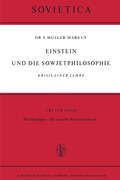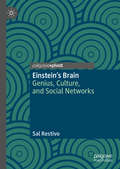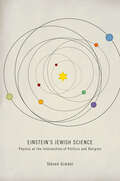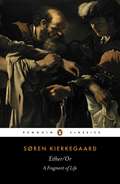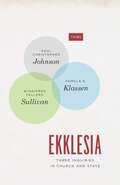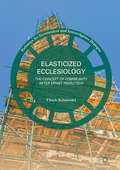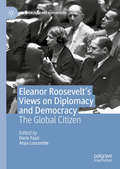- Table View
- List View
Einstein und die Sowjetphilosophie: Krisis Einer Lehre Zweiter Band Die allgemeine Relativitätstheorie (Sovietica #22)
by S. Müller-MarkusEinstein und Die Sowjetphilosophie: Krisis einer Lehre (Sovietica #5)
by S. Müller-MarkusDieses Buch soll ein Bericht über den Prozess Einstein sein. Es enthält das Material über die Diskussion um die Relativitätstheorie in der UdSSR seit 1950. Von 1951 bis 1955 wurde Einstein durch die offizielle Parteiphilosophie der UdSSR in den Anklagezustand versetzt. Der Prozess gipfelte in der Aufforderung, die Relativitätstheorie zu verwerfen und durch eine materialistische 'Theorie schneller Bewegungen' zu ersetzen. Selbst der Name 'Relativitätstheorie' sollte aus den physikalischen Lehrbüchern verschwinden. Die Anklage wurde vertreten von der ideologischen Führungsschicht der gewaltigsten irdischen Macht unseres Zeitalters. Der Angeklagte, in der Reife seines Lebens vor die vehementesten Angriffe gestellt, kam nur durch sein Werk zu Wort. Dies genügte jedoch, dass sich unter den sowjetischen Physikern und Philosophen noch zur Zeit Stalins mannhafte Stimmen der Verteidigung fanden. 1955 wurde der Prozess mit der offiziellen Anerkennung der Relativitäts theorie durch die Parteiphilosophie abgeschlossen. Es war ein Sieg der Wahrheit über die Gewalt. Die Folgen mussten das Ansehen der kommunistischen Ideologie erschüttern. Es hatte sich herausgestellt, dass zwischen der angeblich einzig wissenschaftlichen Philosophie und der exaktesten Naturwissen schaft, der Physik, ein Abgrund klafft, den zu überbrücken die Sowjet philosophie bis heute bemüht ist. Andererseits begannen die sowjetischen Physiker, wachgerufen durch die Appelle der Philosophen, ihr eigenes Weltbild mit adäquaten Methoden zu durchdenken. Diese ganze Ent wicklung ist von hohem Wert für eine Diagnose der geistigen Struktur der Sowjetgesellschaft.
The Einsteinian Revolution: The Historical Roots of His Breakthroughs
by Jürgen Renn Hanoch GutfreundHow the Einsteinian revolution can be understood as the result of a long-term evolution of science The revolution that emerged from Albert Einstein’s work in the early twentieth century transformed our understanding of space, time, motion, gravity, matter, and radiation. Beginning with Einstein’s miracle year of 1905 and continuing through his development of the theory of general relativity, Einstein spurred a revolution that continues to reverberate in modern-day physics. In The Einsteinian Revolution, Hanoch Gutfreund and Jürgen Renn trace the century-long transformation of classical physics and argue that the revolution begun by Einstein was in fact the result of a long-term evolution. Describing the origins and context of Einstein’s innovative research, Gutfreund and Renn work to dispel the popular myth of Einstein as a lone genius who brought about a revolution in physics through the power of his own pure thought. We can only understand the birth of modern physics, they say, if we understand the long history of the evolution of knowledge.Gutfreund and Renn outline the essential structures of the knowledge system of classical physics on which Einstein drew. Examining Einstein’s discoveries from 1905 onward, they describe the process by which new concepts arose and the basis of modern physics emerged. These transformations continued, eventually resulting in the establishment of quantum physics and general relativity as the two major conceptual frameworks of modern physics—and its two unreconciled theoretical approaches. Gutfreund and Renn note that Einstein was dissatisfied with this conceptual dichotomy and began a search for a unified understanding of physics—a quest that continued for the rest of his life.
The Einsteinian Revolution: The Historical Roots of His Breakthroughs
by Jürgen Renn Hanoch GutfreundHow the Einsteinian revolution can be understood as the result of a long-term evolution of science The revolution that emerged from Albert Einstein’s work in the early twentieth century transformed our understanding of space, time, motion, gravity, matter, and radiation. Beginning with Einstein’s miracle year of 1905 and continuing through his development of the theory of general relativity, Einstein spurred a revolution that continues to reverberate in modern-day physics. In The Einsteinian Revolution, Hanoch Gutfreund and Jürgen Renn trace the century-long transformation of classical physics and argue that the revolution begun by Einstein was in fact the result of a long-term evolution. Describing the origins and context of Einstein’s innovative research, Gutfreund and Renn work to dispel the popular myth of Einstein as a lone genius who brought about a revolution in physics through the power of his own pure thought. We can only understand the birth of modern physics, they say, if we understand the long history of the evolution of knowledge.Gutfreund and Renn outline the essential structures of the knowledge system of classical physics on which Einstein drew. Examining Einstein’s discoveries from 1905 onward, they describe the process by which new concepts arose and the basis of modern physics emerged. These transformations continued, eventually resulting in the establishment of quantum physics and general relativity as the two major conceptual frameworks of modern physics—and its two unreconciled theoretical approaches. Gutfreund and Renn note that Einstein was dissatisfied with this conceptual dichotomy and began a search for a unified understanding of physics—a quest that continued for the rest of his life.
Einstein’s Brain: Genius, Culture, and Social Networks
by Sal RestivoThis book reviews the research on Einstein’s brain from a sociological perspective and in the context of the social brain paradigm. Instead of “Einstein, the genius of geniuses” standing on the shoulders of giants, Restivo proposes a concept of Einstein the social being standing on the shoulders of social networks. Rather than challenging Einstein’s uniqueness or the uniqueness of his achievements, the book grounds Einstein and his achievements in a social ecology opposed to the myths of the “I,” individualism, and the very idea of “genius.” “Einstein” is defined by the particular configuration of social networks that he engaged as his life unfolded, not by biological inheritances.
Einstein's Jewish Science: Physics at the Intersection of Politics and Religion
by Steven GimbelIs relativity Jewish? The Nazis denigrated Albert Einstein’s revolutionary theory by calling it "Jewish science," a charge typical of the ideological excesses of Hitler and his followers. Philosopher of science Steven Gimbel explores the many meanings of this provocative phrase and considers whether there is any sense in which Einstein’s theory of relativity is Jewish. Arguing that we must take seriously the possibility that the Nazis were in some measure correct, Gimbel examines Einstein and his work to explore how beliefs, background, and environment may—or may not—have influenced the work of the scientist. You cannot understand Einstein’s science, Gimbel declares, without knowing the history, religion, and philosophy that influenced it. No one, especially Einstein himself, denies Einstein's Jewish heritage, but many are uncomfortable saying that he was being a Jew while he was at his desk working. To understand what "Jewish" means for Einstein’s work, Gimbel first explores the many definitions of "Jewish" and asks whether there are elements of Talmudic thinking apparent in Einstein’s theory of relativity. He applies this line of inquiry to other scientists, including Isaac Newton, René Descartes, Sigmund Freud, and Émile Durkheim, to consider whether their specific religious beliefs or backgrounds manifested in their scientific endeavors. Einstein's Jewish Science intertwines science, history, philosophy, theology, and politics in fresh and fascinating ways to solve the multifaceted riddle of what religion means—and what it means to science. There are some senses, Gimbel claims, in which Jews can find a special connection to E = mc2, and this claim leads to the engaging, spirited debate at the heart of this book.
Einsteins Relativitätstheorie – ihre Entstehung und Machs Einfluss darauf
by Eren SimsekRoman U. Sexl schreibt in seinem Artikel „Der unerschöpfliche Albert Einstein“, dass „gerade rund um die Ursprünge der speziellen Relativitätstheorie einige wesentliche wissenschaftsgeschichtliche Fragen“ noch offen stehen und betont: „Eine der interessantesten Fragen betrifft die Quellen Einsteins.“ Von ihm kommt der wichtige Hinweis, sich Einsteins Kyoto-Rede bzw. die „, inoffizielle Nobelpreisrede‘“ näher anzusehen. Diese Rede, in welcher Einstein genau vor hundert Jahren die Entstehungsgeschichte der Relativitätstheorie erläutert, ist von größerem Interesse, weil Einstein darin oft auf Mach hinweist. Weder der historische Kontext der Rede wurde bis jetzt untersucht noch der Versuch unternommen, den Inhalt der Rede zu rekonstruieren. Betrachtet man den historischen Kontext, erweist sich dieser Vortrag nämlich zum Teil als Einsteins Reaktion auf das (gefälschte) Vorwort in Die Prinzipien der physikalischen Optik, worin E. Mach als Relativitätstheorie-Gegner dargestellt wurde. Einstein macht in seiner Rede darauf aufmerksam, welch wichtige erkenntnistheoretische Rolle Machs Arbeiten für ihn hatten. Aufgrund der neuen Ergebnisse in der Mach-Einstein-Forschung werden in dieser Arbeit daher die Entstehungsgeschichte der Relativitätstheorie sowie der Inhalt der Kyoto-Rede wissenschaftsgeschichtlich rekonstruiert und Machs Einfluss darauf genauer analysiert.
Einstein's Theory: A Rigorous Introduction for the Mathematically Untrained
by Øyvind Grøn Arne NæssThis book provides an introduction to the theory of relativity and the mathematics used in its processes. Three elements of the book make it stand apart from previously published books on the theory of relativity. First, the book starts at a lower mathematical level than standard books with tensor calculus of sufficient maturity to make it possible to give detailed calculations of relativistic predictions of practical experiments. Self-contained introductions are given, for example vector calculus, differential calculus and integrations. Second, in-between calculations have been included, making it possible for the non-technical reader to follow step-by-step calculations. Thirdly, the conceptual development is gradual and rigorous in order to provide the inexperienced reader with a philosophically satisfying understanding of the theory. The goal of this book is to provide the reader with a sound conceptual understanding of both the special and general theories of relativity, and gain an insight into how the mathematics of the theory can be utilized to calculate relativistic effects.
Einstein's Tutor: The Story of Emmy Noether and the Invention of Modern Physics
by Lee PhillipsA revelatory story of the woman who made foundational contributions to science and mathematics and persevered in the face of discrimination. Emmy Noether's mathematical genius enabled Einstein to bring his General Theory of Relativity–the basis of our current theory of gravity–to fruition. On a larger scale, what came to be known as &“Noether&’s Theorem&”—called by a Nobel laureate &“the single most profound result in all of physics&”—supplied the basis for the most accurate theory in the history of physics, the Standard Model, which forms our modern theory of matter. Noether&’s life story is equally important and revelatory in understanding the pernicious nature of sexual prejudice in the sciences, revealing the shocking discrimination against one of the true intellectual giants of the twentieth century, a woman effectively excluded from the opportunities given to her male counterparts. Noether&’s personality and optimistic spirit, as Lee Phillips reveals, enabled her unique genius to persevere and arrive at insights that still astonish those who encounter them a century later.
Einstellungen von Kindern gegenüber Peers mit Förderbedarf: Die Rolle persönlicher Ressourcen für die soziale Partizipation
by Marwin Felix LöperDie Einstellungen von Grundschulkindern gegenüber Peers mit Förderbedarf stellen eine wichtige Voraussetzung für die soziale Partizipation von Kindern mit emotional-sozialem Förderbedarf im inklusiven Grundschulunterricht dar. Vor diesem Hintergrund geht Marwin Felix Löper in diesem Buch der Frage nach, ob und inwiefern sich die Einstellungen von Grundschulkindern gegenüber Peers mit emotional-sozialem Förderbedarf durch ihre Empathie, ihren bisherigen Kontakt zu Menschen mit Förderbedarf und ihr soziales Selbstkonzept erklären lassen. Hierbei konnte er nachweisen, dass die Fürsorglichkeit – als Teil der Empathie – und der Kontakt zu Menschen mit Förderbedarf prädiktiv für die Einstellungen von Grundschulkindern zu Peers mit emotional-sozialem Förderbedarf sind.
Einstieg in die beweisorientierte Mathematik: Mit Versuch und Irrtum zum Beweis
by Felix Göbler Alex KüronyaDie Schulmathematik vermittelt meist nur einen sehr eingeschränkten Einblick in die beweisorientierte und axiomatisch aufgebaute moderne Mathematik – Studienanfänger werden daher oft unvorbereitet von der Hochschulmathematik getroffen. Dieses Lehrbuch erleichtert den nötigen Übergang zum selbstständigen Erarbeiten und Lernen mathematischer Beweise und Inhalte: Es motiviert die Lesenden, selbst aktiv zu werden und sich alleine an den gegebenen Problemstellungen zu versuchen. Dabei wird viel Wert auf leichte Sprache, ausführliche Erklärungen und detaillierte Beispiele gelegt. Somit ist das Buch optimal zum Selbststudium, als Material für Online-Lehrveranstaltungen oder als Ergänzung zu klassischen Mathematik-Vorkursen geeignet. Die einzelnen Kapitel können weitgehend eigenständig und selektiv gelesen bzw. bearbeitet werden, sind aber einheitlich aufgebaut: Jedes Kapitel orientiert sich inhaltlich an einer zu Beginn dargestellten Leitfrage. Auf dem Weg zur Antwort werden die Lesenden von ausführlichen Erläuterungen, Schnellaufgaben, klassischen Übungsaufgaben und Wiederholungsaufgaben begleitet. Die Relevanz der Ergebnisse wird abschließend erläutert; an einigen Stellen gehen die Autoren sogar auf aktuelle Forschung ein oder geben Ausblicke auf tiefere mathematische Erkenntnisse. Die mathematische Basis dieses Buchs ist die zweisemestrige Vorlesung zur Elementarmathematik für das Haupt- und Realschul-Lehramt an der Goethe Universität Frankfurt. Daher eignet sich das Buch besonders gut für Lehramtsstudierende (auch für das gymnasiale Lehramt), als Anregung für Lehrkräfte oder als Ausblick für motivierte Schüler sowie als Brückenkursmaterial.
Eisenhower, Macmillan and Allied Unity, 1957–1961
by E. Geelhoed A. EdmondsBetween 1957-1961, Dwight D. Eisenhower and Harold Macmillan restored the 'Special Relationship' between the United States and Great Britain after the Suez Crisis of 1956 threatened to divide these longtime allies. Their diplomatic partnership, designed to keep the peace during one of the most difficult periods of the Cold War, was based on their personal friendship, the system of bilateral consultations which they established, and the program of defence co-operation which they instituted. In this fascinating study, Geelhoed and Edmonds explore the most important diplomatic partnership of the 1950s.
Either/Or: A Fragment of Life
by Alastair Hannay Soren Kierkegaard Victor EremitaIn Either/Or, using the voices of two characters - the aesthetic young man of part one, called simply 'A', and the ethical Judge Vilhelm of the second section - Kierkegaard reflects upon the search for a meaningful existence, contemplating subjects as diverse as Mozart, drama, boredom, and, in the famous Seducer's Diary, the cynical seduction and ultimate rejection of a young, beautiful woman. A masterpiece of duality, Either/Or is a brilliant exploration of the conflict between the aesthetic and the ethical - both meditating ironically and seductively upon Epicurean pleasures, and eloquently expounding the noble virtues of a morally upstanding life.
Ekklesia: Three Inquiries in Church and State (TRIOS)
by Paul Christopher Johnson Pamela E. Klassen Winnifred Fallers SullivanEkklesia: Three Inquiries in Church and State offers a New World rejoinder to the largely Europe-centered academic discourse on church and state. In contrast to what is often assumed, in the Americas the relationship between church and state has not been one of freedom or separation but one of unstable and adaptable collusion. Ekklesia sees in the settler states of North and South America alternative patterns of conjoined religious and political power, patterns resulting from the undertow of other gods, other peoples, and other claims to sovereignty. These local challenges have led to a continuously contested attempt to realize a church-minded state, a state-minded church, and the systems that develop in their concert. The shifting borders of their separation and the episodic conjoining of church and state took new forms in both theory and practice. The first of a closely linked trio of essays is by Paul Johnson, and offers a new interpretation of the Brazilian community gathered at Canudos and its massacre in 1896–97, carried out as a joint churchstate mission and spectacle. In the second essay, Pamela Klassen argues that the colonial churchstate relationship of Canada came into being through local and national practices that emerged as Indigenous nations responded to and resisted becoming “possessions” of colonial British America. Finally, Winnifred Sullivan’s essay begins with reflection on the increased effort within the United States to ban Bibles and scriptural references from death penalty courtrooms and jury rooms; she follows with a consideration of the political theological pressure thereby placed on the jury that decides between life and death. Through these three inquiries, Ekklesia takes up the familiar topos of “church and state” in order to render it strange.
Ekklesia: Three Inquiries in Church and State (TRIOS)
by Paul Christopher Johnson Pamela E. Klassen Winnifred Fallers SullivanEkklesia: Three Inquiries in Church and State offers a New World rejoinder to the largely Europe-centered academic discourse on church and state. In contrast to what is often assumed, in the Americas the relationship between church and state has not been one of freedom or separation but one of unstable and adaptable collusion. Ekklesia sees in the settler states of North and South America alternative patterns of conjoined religious and political power, patterns resulting from the undertow of other gods, other peoples, and other claims to sovereignty. These local challenges have led to a continuously contested attempt to realize a church-minded state, a state-minded church, and the systems that develop in their concert. The shifting borders of their separation and the episodic conjoining of church and state took new forms in both theory and practice. The first of a closely linked trio of essays is by Paul Johnson, and offers a new interpretation of the Brazilian community gathered at Canudos and its massacre in 1896–97, carried out as a joint churchstate mission and spectacle. In the second essay, Pamela Klassen argues that the colonial churchstate relationship of Canada came into being through local and national practices that emerged as Indigenous nations responded to and resisted becoming “possessions” of colonial British America. Finally, Winnifred Sullivan’s essay begins with reflection on the increased effort within the United States to ban Bibles and scriptural references from death penalty courtrooms and jury rooms; she follows with a consideration of the political theological pressure thereby placed on the jury that decides between life and death. Through these three inquiries, Ekklesia takes up the familiar topos of “church and state” in order to render it strange.
Ekklesia: Three Inquiries in Church and State (TRIOS)
by Paul Christopher Johnson Pamela E. Klassen Winnifred Fallers SullivanEkklesia: Three Inquiries in Church and State offers a New World rejoinder to the largely Europe-centered academic discourse on church and state. In contrast to what is often assumed, in the Americas the relationship between church and state has not been one of freedom or separation but one of unstable and adaptable collusion. Ekklesia sees in the settler states of North and South America alternative patterns of conjoined religious and political power, patterns resulting from the undertow of other gods, other peoples, and other claims to sovereignty. These local challenges have led to a continuously contested attempt to realize a church-minded state, a state-minded church, and the systems that develop in their concert. The shifting borders of their separation and the episodic conjoining of church and state took new forms in both theory and practice. The first of a closely linked trio of essays is by Paul Johnson, and offers a new interpretation of the Brazilian community gathered at Canudos and its massacre in 1896–97, carried out as a joint churchstate mission and spectacle. In the second essay, Pamela Klassen argues that the colonial churchstate relationship of Canada came into being through local and national practices that emerged as Indigenous nations responded to and resisted becoming “possessions” of colonial British America. Finally, Winnifred Sullivan’s essay begins with reflection on the increased effort within the United States to ban Bibles and scriptural references from death penalty courtrooms and jury rooms; she follows with a consideration of the political theological pressure thereby placed on the jury that decides between life and death. Through these three inquiries, Ekklesia takes up the familiar topos of “church and state” in order to render it strange.
Ekklesia: Three Inquiries in Church and State (TRIOS)
by Paul Christopher Johnson Pamela E. Klassen Winnifred Fallers SullivanEkklesia: Three Inquiries in Church and State offers a New World rejoinder to the largely Europe-centered academic discourse on church and state. In contrast to what is often assumed, in the Americas the relationship between church and state has not been one of freedom or separation but one of unstable and adaptable collusion. Ekklesia sees in the settler states of North and South America alternative patterns of conjoined religious and political power, patterns resulting from the undertow of other gods, other peoples, and other claims to sovereignty. These local challenges have led to a continuously contested attempt to realize a church-minded state, a state-minded church, and the systems that develop in their concert. The shifting borders of their separation and the episodic conjoining of church and state took new forms in both theory and practice. The first of a closely linked trio of essays is by Paul Johnson, and offers a new interpretation of the Brazilian community gathered at Canudos and its massacre in 1896–97, carried out as a joint churchstate mission and spectacle. In the second essay, Pamela Klassen argues that the colonial churchstate relationship of Canada came into being through local and national practices that emerged as Indigenous nations responded to and resisted becoming “possessions” of colonial British America. Finally, Winnifred Sullivan’s essay begins with reflection on the increased effort within the United States to ban Bibles and scriptural references from death penalty courtrooms and jury rooms; she follows with a consideration of the political theological pressure thereby placed on the jury that decides between life and death. Through these three inquiries, Ekklesia takes up the familiar topos of “church and state” in order to render it strange.
Ekklesia: Three Inquiries in Church and State (TRIOS)
by Paul Christopher Johnson Pamela E. Klassen Winnifred Fallers SullivanEkklesia: Three Inquiries in Church and State offers a New World rejoinder to the largely Europe-centered academic discourse on church and state. In contrast to what is often assumed, in the Americas the relationship between church and state has not been one of freedom or separation but one of unstable and adaptable collusion. Ekklesia sees in the settler states of North and South America alternative patterns of conjoined religious and political power, patterns resulting from the undertow of other gods, other peoples, and other claims to sovereignty. These local challenges have led to a continuously contested attempt to realize a church-minded state, a state-minded church, and the systems that develop in their concert. The shifting borders of their separation and the episodic conjoining of church and state took new forms in both theory and practice. The first of a closely linked trio of essays is by Paul Johnson, and offers a new interpretation of the Brazilian community gathered at Canudos and its massacre in 1896–97, carried out as a joint churchstate mission and spectacle. In the second essay, Pamela Klassen argues that the colonial churchstate relationship of Canada came into being through local and national practices that emerged as Indigenous nations responded to and resisted becoming “possessions” of colonial British America. Finally, Winnifred Sullivan’s essay begins with reflection on the increased effort within the United States to ban Bibles and scriptural references from death penalty courtrooms and jury rooms; she follows with a consideration of the political theological pressure thereby placed on the jury that decides between life and death. Through these three inquiries, Ekklesia takes up the familiar topos of “church and state” in order to render it strange.
Ekklesia: Three Inquiries in Church and State (TRIOS)
by Paul Christopher Johnson Pamela E. Klassen Winnifred Fallers SullivanEkklesia: Three Inquiries in Church and State offers a New World rejoinder to the largely Europe-centered academic discourse on church and state. In contrast to what is often assumed, in the Americas the relationship between church and state has not been one of freedom or separation but one of unstable and adaptable collusion. Ekklesia sees in the settler states of North and South America alternative patterns of conjoined religious and political power, patterns resulting from the undertow of other gods, other peoples, and other claims to sovereignty. These local challenges have led to a continuously contested attempt to realize a church-minded state, a state-minded church, and the systems that develop in their concert. The shifting borders of their separation and the episodic conjoining of church and state took new forms in both theory and practice. The first of a closely linked trio of essays is by Paul Johnson, and offers a new interpretation of the Brazilian community gathered at Canudos and its massacre in 1896–97, carried out as a joint churchstate mission and spectacle. In the second essay, Pamela Klassen argues that the colonial churchstate relationship of Canada came into being through local and national practices that emerged as Indigenous nations responded to and resisted becoming “possessions” of colonial British America. Finally, Winnifred Sullivan’s essay begins with reflection on the increased effort within the United States to ban Bibles and scriptural references from death penalty courtrooms and jury rooms; she follows with a consideration of the political theological pressure thereby placed on the jury that decides between life and death. Through these three inquiries, Ekklesia takes up the familiar topos of “church and state” in order to render it strange.
Elasticized Ecclesiology: The Concept of Community after Ernst Troeltsch
by Ulrich SchmiedelThis study confronts the current crisis of churches. In critical and creative conversation with the German theologian Ernst Troeltsch (1865-1923), Ulrich Schmiedel argues that churches need to be “elasticized” in order to engage the “other.” Examining contested concepts of religiosity, community, and identity, Schmiedel explores how the closure of church against the sociological “other” corresponds to the closure of church against the theological “other.” Taking trust as a central category, he advocates for a turn in the interpretation of Christianity—from “propositional possession” to “performative project,” so that the identity of Christianity is “done” rather than “described.” Through explorations of classical and contemporary scholarship in philosophy, sociology, and theology, Schmiedel retrieves Troeltsch’s interdisciplinary thinking for use in relation to the controversies that encircle the construction of community today. The study opens up innovative and instructive approaches to the investigation of the practices of Christianity, past and present. Eventually, church emerges as a “work in movement,” continually constituted through encounters with the sociological and the theological “other.”
Elasticized Ecclesiology: The Concept of Community after Ernst Troeltsch
by Ulrich SchmiedelThis study confronts the current crisis of churches. In critical and creative conversation with the German theologian Ernst Troeltsch (1865-1923), Ulrich Schmiedel argues that churches need to be “elasticized” in order to engage the “other.” Examining contested concepts of religiosity, community, and identity, Schmiedel explores how the closure of church against the sociological “other” corresponds to the closure of church against the theological “other.” Taking trust as a central category, he advocates for a turn in the interpretation of Christianity—from “propositional possession” to “performative project,” so that the identity of Christianity is “done” rather than “described.” Through explorations of classical and contemporary scholarship in philosophy, sociology, and theology, Schmiedel retrieves Troeltsch’s interdisciplinary thinking for use in relation to the controversies that encircle the construction of community today. The study opens up innovative and instructive approaches to the investigation of the practices of Christianity, past and present. Eventually, church emerges as a “work in movement,” continually constituted through encounters with the sociological and the theological “other.”
Eleanor Roosevelt and Adlai Stevenson (The World of the Roosevelts)
by Richard HenryThe mutually energizing and often volatile friendship between Eleanor Roosevelt and Adlai Stevenson - unexplored in depth by scholars until this study - was one of the last century s remarkable political alliances. Both Stevenson and Eleanor Roosevelt shared a view of politics as a moral enterprise, one in which the fulfillment of its "mission" was the betterment of the human condition. This belief was the foundation upon which their legislative initiatives were constructed. Employing letters and diaries as well as contemporary media accounts, this book examines the perspectives, the convictions, the style, and the spirit that both principals brought to the calling of public service.
Eleanor Roosevelt and the Anti-Nuclear Movement: The Voice of Conscience (The World of the Roosevelts)
by Dario FazziThis book explores Eleanor Roosevelt’s involvement in the global campaign for nuclear disarmament. Based on an extensive multi-archival research, it assesses her overall contribution to the global anti-nuclear campaign of the early cold war and shows how she constantly tried to raise awareness of the real hazards of nuclear testing. She strove to educate the general public about the implications of the nuclear arms race and, in doing so, she became for many a trustworthy anti-nuclear leader and a reliable voice of conscience.
Eleanor Roosevelt's Views on Diplomacy and Democracy: The Global Citizen (The World of the Roosevelts)
by Dario Fazzi Anya Luscombe"This volume fills a void in current studies of Eleanor Roosevelt. Offering a comprehensive analysis of Roosevelt as a diplomat during the Cold War era, it is particularly insightful in analyzing her position on United States race relations while at the United Nations. It provides a new look at Roosevelt’s leadership from an American perspective played out on a global stage."- Maurine H. Beasley, Professor Emerita, University of Maryland College Park, USA"My grandmother was an ardent "small-d" democrat, as well as a Democrat - but she didn't think we were very mature in our living of it! This well-written and illuminating collection of essays, focused on what ER thought it meant to be a global citizen, offers a unique perspective of her views on a host of issues. Let us hope these fresh insights can inspire young people today to construct that better world to which she dedicated much of her life."- Anna Eleanor RooseveltThis book focuses on Eleanor Roosevelt’s multifaceted agenda for the world. It highlights her advocacy of human rights, multilateral diplomacy, and transnationalism, and it emphasizes her challenge to gendered norms and racial relations. The essays of this collection describe Eleanor Roosevelt as a public intellectual, a politician, a public diplomat, and an activist. She was, undeniably, one of the protagonists of the twentieth century and a proactive interpreter of the many changes it brought about. She went through two world wars, the harshness of the Great Depression, and the emergence of nuclear confrontation, and she deciphered such crises as the product of misleading nationalism and egoism. Against them, she offered her commitment to people’s education as an example of civic engagement, which she considered necessary for the functioning of any democratic order. Such was the world Eleanor Roosevelt envisioned and tried to build – symbolically and practically – one where people, the citizens of the world, may really be at the center of international affairs.
Electing the Senate: Indirect Democracy before the Seventeenth Amendment
by Wendy J. Schiller Charles Stewart IIIFrom 1789 to 1913, U.S. senators were not directly elected by the people—instead the Constitution mandated that they be chosen by state legislators. This radically changed in 1913, when the Seventeenth Amendment to the Constitution was ratified, giving the public a direct vote. Electing the Senate investigates the electoral connections among constituents, state legislators, political parties, and U.S. senators during the age of indirect elections. Wendy Schiller and Charles Stewart find that even though parties controlled the partisan affiliation of the winning candidate for Senate, they had much less control over the universe of candidates who competed for votes in Senate elections and the parties did not always succeed in resolving internal conflict among their rank and file. Party politics, money, and personal ambition dominated the election process, in a system originally designed to insulate the Senate from public pressure.Electing the Senate uses an original data set of all the roll call votes cast by state legislators for U.S. senators from 1871 to 1913 and all state legislators who served during this time. Newspaper and biographical accounts uncover vivid stories of the political maneuvering, corruption, and partisanship—played out by elite political actors, from elected officials, to party machine bosses, to wealthy business owners—that dominated the indirect Senate elections process. Electing the Senate raises important questions about the effectiveness of Constitutional reforms, such as the Seventeenth Amendment, that promised to produce a more responsive and accountable government.

